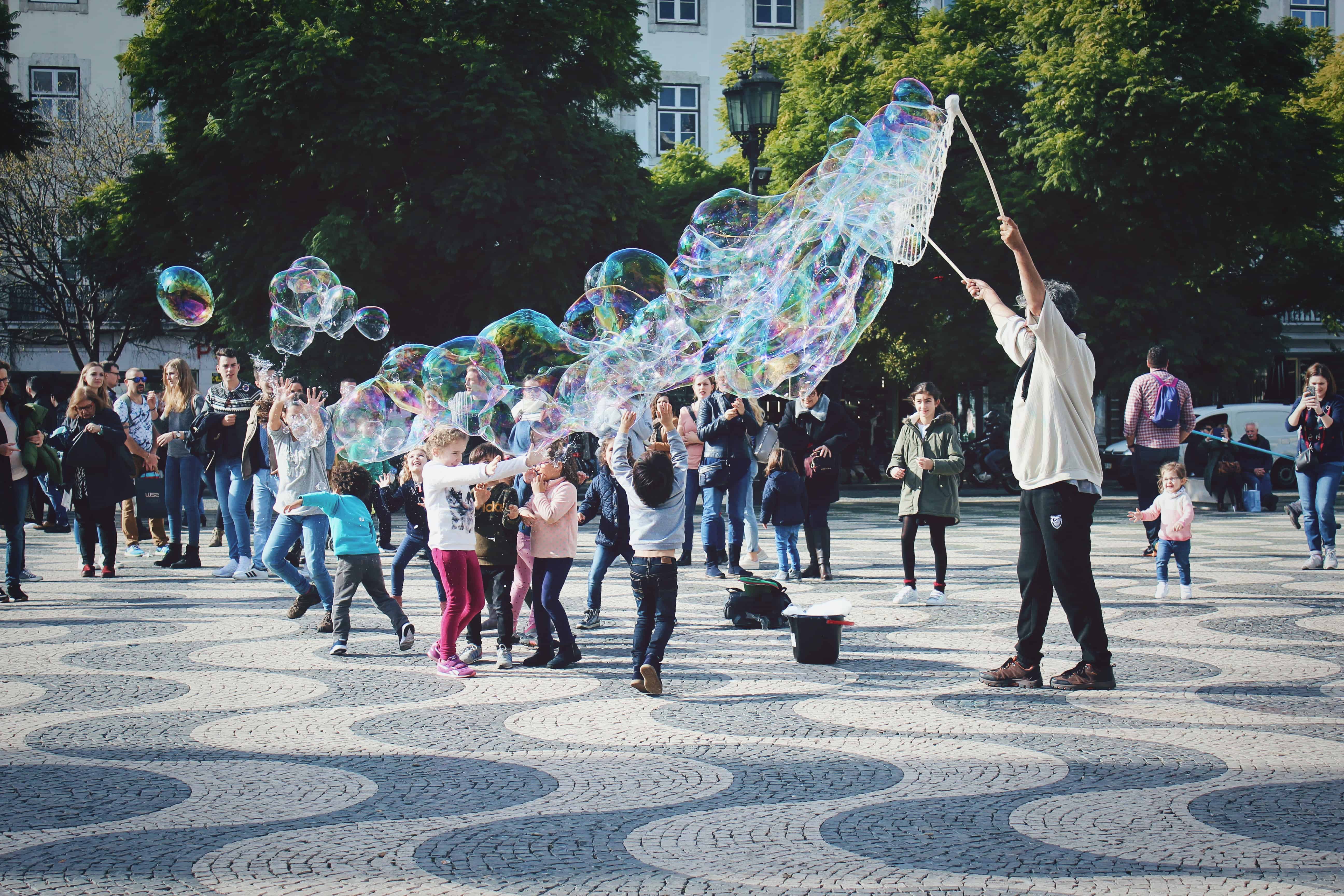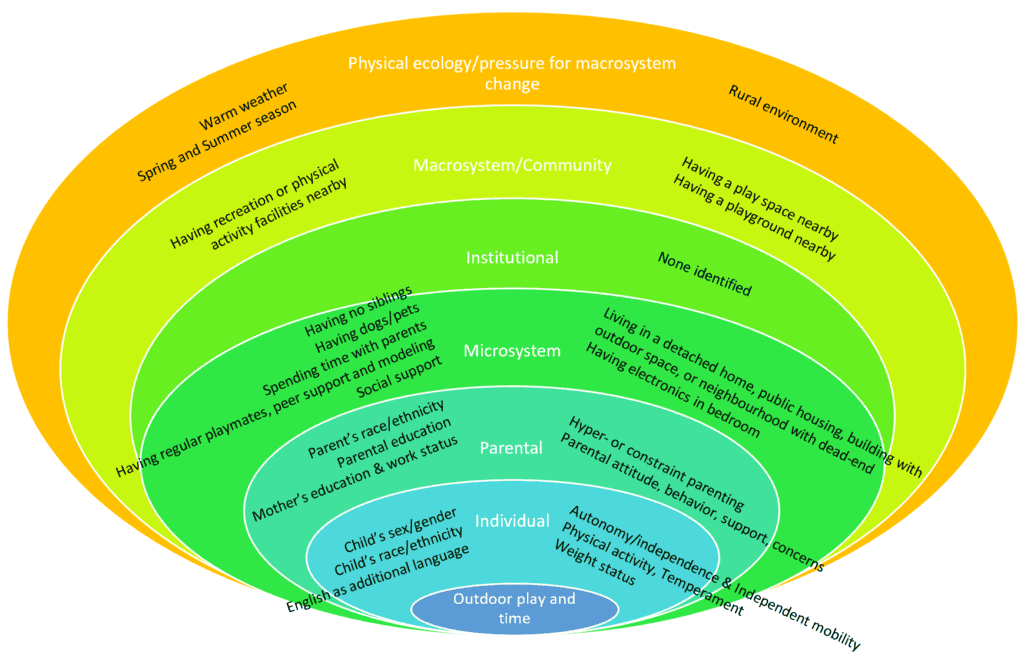
How adults can work together to provide more outdoor opportunities for our children in the coming era
Thank you to Eun-Young Lee, PhD, School of Kinesiology & Health Studies at Queen’s University, Kingston, Canada, Stephen Hunter, PhD Candidate, Faculty of Kinesiology, Sport and Recreation at the University of Alberta, Edmonton, Canada, and Mark S. Tremblay, PhD, Healthy Active Living and Obesity Research Group, Children’s Hospital of Eastern Ontario Research Institute, Ottawa, Canada, for providing this post.
Outdoor play or simply spending time outdoors has a myriad of benefits for healthy growth and development among children. More importantly, playing or spending time outdoors is fun for children, when it is led by children themselves. Despite such advantages, evidence suggests that outdoor play or time among children have been decreasing over the years (1). There are potentially multiple layers of influence on such decrease, including lifestyle changes (2) due to urbanization (3) and technological advancement (4), children’s safety and parental concerns (5,6), and changing social norms around children’s independent mobility (1,7). Opportunities for children to engage with outdoor, natural environments may continue to decrease in a constantly evolving socio-environmental world. This has become especially apparent during the current COVID-19 pandemic, where mass home-confinement directives and restrictions on the use of public outdoor spaces are deterring outdoor play among children (8–10).
Factors influencing children’s outdoor play and time
A recent systematic review published in the International Journal of Behavioral Nutrition and Physical Activity has examined potential factors that could influence participation in outdoor play and time among children aged 3-12 years (11). Based on 107 academic articles in English, Mandarin Chinese, Portuguese, and Spanish from 29 countries, the findings of this review highlight that not all children have equal access and opportunities for outdoor play and time. This review identified several key factors that could influence children’s outdoor play and time in the modern era. Following the structure of socioecological modelling, the identified key factors are organized in Figure 1, below.

Figure 1. Factors influencing outdoor play and time among children aged 3-12 years within the socioecological modelling framework.
A number of individual level factors appear to influence children’s participation in outdoor play and time.
Being a boy, being part of the dominant racial/ethnic group and having English as first language, having higher autonomy/independence and more independent mobility, engaging in more physical activity, having a more active temperament, and exhibiting healthy weight status were conditions that were more conducive to outdoor play and time.
At the parental level, parent’s race/ethnicity (membership to the dominant group), education (lower education), and mother’s work status (not working) appear to provide more opportunities for children’s outdoor play and time. Parental support (i.e., co-participation, encouragement, modeling, and instrumental support), behaviour (i.e., outdoor activity, walking, organized sport, and overall physical activity), and attitude (i.e., towards nature, recreation, walking, and child’s physical activity) were all found to be conducive to children’s outdoor play and time. However, parental concerns toward child’s outdoor play being risky or unsafe and hyper- or constraint parenting were associated with limited opportunities for outdoor play and time.
At the microsystem level, having no siblings but dogs/pets at home, spending more time with parents, having regular playmates, having support from and modeling peers for outdoor play seem to help children engage in more time outdoors and in play. Furthermore, having a play space at a friend’s or relative’s house, support/reinforcement from adults other than parents, and having more social support and capital related to child’s physical activity and obesity were also associated with more time outdoors and in play among children. In terms of the physical environment of children’s homes, living in a detached home, public housing, a building with outdoor space, or neighbourhood dead-ends/cul-de-sacs were associated with providing more outdoor opportunities for children. Surprisingly, having electronics in a child’s bedroom was also associated with higher outdoor play and time.
At the macrosystem and community level, having recreation and physical activity facilities, play space, and playgrounds nearby in the neighbourhood appear to provide more outdoor opportunities for children.
At the most distal level (physical ecology), warm temperatures, spring and summer seasons, and rural vs suburban or urban environments were associated with higher outdoor play and time among children.
To summarize, children’s outdoor play/time appears to be influenced by many factors within a socioecological model. Both individual and parental-level correlates likely interact within the overarching family systems at the microsystem level. For instance, the sociocultural environment of which parents are a part of based on the sociodemographic background of parents and their children may likely influence their choice for neighbourhood and dwelling as well as their practices and support in providing outdoor opportunities. Parental concerns around safety, intertwined with broader societal issues such as reduced sense of community or changes in employment patterns and long work hours could act as barriers for parents in providing their child with opportunities for outdoor play and time (12).
not all children have equal access and opportunities for outdoor play and time
In a similar vein, it is noteworthy that many parents may not necessarily choose where they live and how they raise their children but structural factors such as the socioeconomical condition of parents may very likely limit their abilities to choose and accordingly determine their options for living and child-rearing, thus, influencing their decisions on their home and neighbourhood. In addition to the proximal physical and social environment, the distal physical and ecological environment such as neighbourhood infrastructure (i.e., play space, playground, recreation or physical activity facilities) and ecology (i.e., warm weather, spring and summer season, and rurality) for outdoor play and time also appear to play a role.
Considerations for providing more outdoor opportunities for children
Children are born to play. And the benefits of play can be maximized when children are outdoors. However, the conditions in which children are born and live likely create unequal opportunities for outdoor play and time. Therefore, it is our responsibility as adults to ensure we provide equal opportunities for every child to play freely, learn and socialize, and enjoy and thrive outdoors.
The increasing need for providing more outdoor opportunities for our children has come to the forefront, particularly with the negative consequences of the COVID-19 pandemic on children’s behaviour and health (13–15). Based on the influencing factors identified in the review (11), a few realistic suggestions are offered below for parents and communities, researchers, urban planners, and policy makers for creating more equitable outdoor opportunities for our children. Though the review did not find any key influencing factors to outdoor play and time, we made suggestions based on the studies included in the review that provided preliminary findings (16–19).
For parents and communities
- Collective action: Get connected with your community members and together create a free-range environment while ensuring safety to increase outdoor opportunities for all children in your neighbourhood bubble.
- Inclusive action: Ensure gender- and race/ethnic-diversity for your children’s playgroups and community programs to not only promote social cohesion of the community but also foster inclusive values in your children and community. Newcomers to Canada may experience extra challenges in getting their children outside due to language barriers or social norm differences around safety and education (20). Community resources and programmes for newcomer families and children should keep such cross-cultural differences in mind when fostering outdoor opportunities.
For educators and practitioners
- Early Childhood Education and Care (ECEC) outdoor environments and scheduled outdoor programming: Having more shade and more greenery appear to be important for children’s outdoor play and time during care. Also, given that the fall/winter seasons and cold weather typically act as barriers to outdoor opportunities, ECEC programming should incorporate all-weather outdoor opportunities to ensure that children spend time playing outdoors each day.
- Child-centred practices: Focus more on children’s play itself as freely chosen and self-directed while focusing less on adult-led activities and supervision to help children have more fun and be happy outside.
For researchers
- Terminology: Establish clear definitions and operationalization of outdoor play, outdoor time, and other relevant terms to not only reduce the confusion that exists in the field but also advance the measurement of outdoor play and outdoor time.
- Mechanisms: Examine mechanisms (i.e., interactions and processes between variables at different levels of socioecological modelling) to help explain limited consistency and evidence observed at the distal levels of the socioecological model as well as the finding of no evidence at the institutional level. This is particularly important because ECEC is known to play a critical role in shaping children’s behaviour during hours in care (16,21).
- Context, context, context: More nuanced investigations, recommendations, and intervention strategies may be required, particularly for children who are underprivileged, given that the conditions in which children are born, live, and play vary greatly across individuals, neighbourhoods, communities, religions, cultures, and countries.
Urban planners and Policymakers
- Infrastructural needs: Having outdoor recreation and physical activity facilities, play space, and playgrounds in each residential neighbourhood appears to be important
- Rural landscape in urban areas: Given the continuing urbanization and development globally, it may be important to conserve natural environments in rural areas while creating more green spaces in urban centres.
Read the original systematic review here.
References
- Tremblay MS, Gray C, Babcock S, Barnes JD, Bradstreet CC, Carr D, et al. Position statement on active outdoor play. Int J Environ Res Public Health. 2015;12(6):6475–505.
- Tremblay MS, Esliger DW, Tremblay A, Colley R. Incidental movement, lifestyle-embedded activity and sleep: New frontiers in physical activity assessment. Appl Physiol Nutr Metab. 2007;32(Suppl 2):S208-17.
- United Nations. World Urbanization Prospects The 2018 Revision [Internet]. Prospects. New York; 2018 [cited 2018 Oct 5]. Available from: https://population.un.org/wup/Publications/Files/WUP2018-KeyFacts.pdf
- York R, Rosa EA, Dietz T. Footprints on the earth: The environmental consequences of modernity. Am Sociol Rev. 2003;68(2):279–300.
- Valentine G, McKendrck J. Children’s outdoor play: Exploring parental concerns about children’s safety and the changing nature of childhood. Geoforum. 1997;28(2):219–35.
- Brussoni M, Olsen LL, Pike I, Sleet DA. Risky play and children’s safety: Balancing priorities for optimal child development. Int J Environ Res Public Health. 2012;9(9):3134–48.
- Kyttä M, Hirvonen J, Rudner J, Pirjola I, Laatikainen T. The last free-range children? Children’s independent mobility in Finland in the 1990s and 2010s. J Transp Geogr. 2015;47:1–12.
- Guerrero MD, Vanderloo LM, Rhodes RE, Faulkner G, Moore SA, Tremblay MS. Canadian children’s and youth’s adherence to the 24-h movement guidelines during the COVID-19 pandemic: A decision tree analysis. J Sport Heal Sci. 2020;
- de Lannoy L, Rhodes RE, Moore SA, Faulkner G, Tremblay MS. Regional differences in access to the outdoors and outdoor play of Canadian children and youth during the COVID-19 outbreak. Can J Public Health. 2020;111:988-994.
- Mitra R, Moore SA, Gillespie M, Faulkner G, Vanderloo LM, Chulak-Bozzer T, et al. Healthy movement behaviours in children and youth during the COVID-19 pandemic: Exploring the role of the neighbourhood environment. Health Place. 2020 1;65:102418.
- Lee E-Y, Bains A, Hunter S, Ament A, Brazo-Sayavera J, Carson V, et al. Systematic review of the correlates of outdoor play and time among children aged 3-12 years. Int J Behav Nutr Phys Act. 2021;18(1):41.
- Lee H, Tamminen KA, Clark AM, Slater L, Spence JC, Holt NL. A meta-study of qualitative research examining determinants of children’s independent active free play. Int J Behav Nutr Phys Act. 2015;12(1):5.
- Reilly JJ, Tremblay MS. Rewild your kids: why playing outside should be a post-pandemic priority [Internet]. The Conversation. 2021 [cited 2021 Mar 12]. Available from: https://theconversation.com/rewild-your-kids-why-playing-outside-should-be-a-post-pandemic-priority-156077
- Alden C. Coronavirus spotlights equity and access issues with children’ s right to play [Internet]. The Conversation. 2020 [cited 2021 Mar 12]. p. 1–5. Available from: https://theconversation.com/coronavirus-spotlights-equity-and-access-issues-with-childrens-right-to-play-137187
- McNamara L, Sahlberg P. Kids will need recess more than ever when returning to school post-coronavirus [Internet]. The Conversation. 2020 [cited 2021 Mar 12]. Available from: https://theconversation.com/kids-will-need-recess-more-than-ever-when-returning-to-school-post-coronavirus-139165
- Predy M, Holt N, Carson V. Examining correlates of outdoor play in childcare centres. Can J Public Heal. 2020;
- Hinkley T, Carson V, Hesketh KD. Physical environments, policies and practices for physical activity and screen-based sedentary behaviour among preschoolers within child care centres in Melbourne, Australia and Kingston, Canada. Child Care Health Dev. 2015;41(1):132–8.
- Christian H, Lester L, Trost SG, Trapp G, Schipperijn J, Boruff B, et al. Shade coverage, ultraviolet radiation and children’s physical activity in early childhood education and care. Int J Public Health. 2019;64(9):1325–33.
- Nystrom CD, Barnes JD, Blanchette S, Faulkner G, Leduc G, Riazi NA, et al. Relationships between area-level socioeconomic status and urbanization with active transportation, independent mobility, outdoor time, and physical activity among Canadian children. BMC Public Health. 2019;19.
- Li G. Immigrant children’s play can clash with mainstream cultures [Internet]. The Conversation. 2017 [cited 2021 Mar 12]. Available from: https://theconversation.com/immigrant-childrens-play-can-clash-with-mainstream-cultures-81927#:~:text= Immigrant children’s play can clash with mainstream,an important factor that affects how… More
- Vanderloo LM, Tucker P, Johnson AM, Burke SM, Irwin JD. Environmental influences on preschoolers’ physical activity levels in various early-learning facilities. Res Q Exerc Sport. 2015;86(4):360–70.

